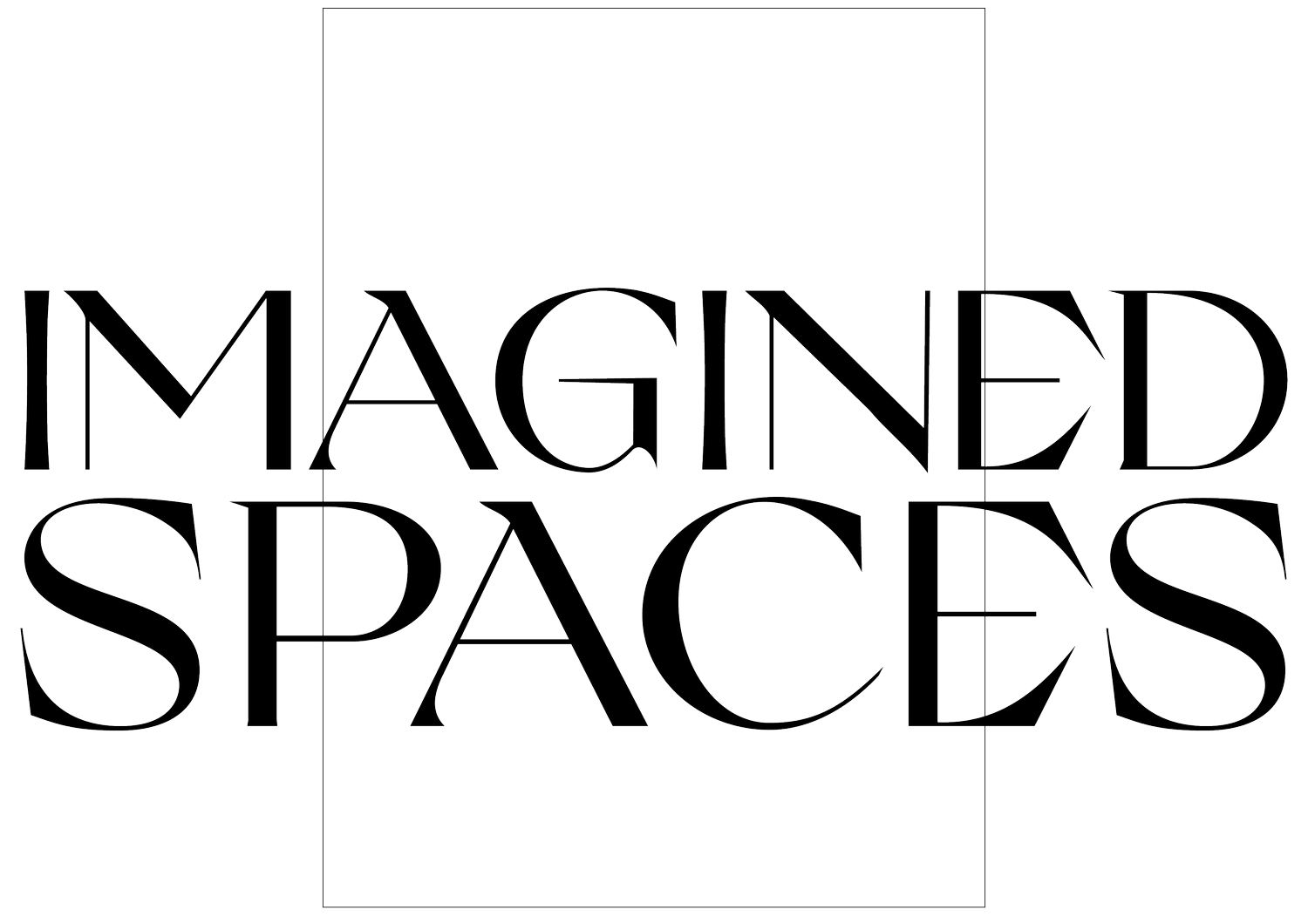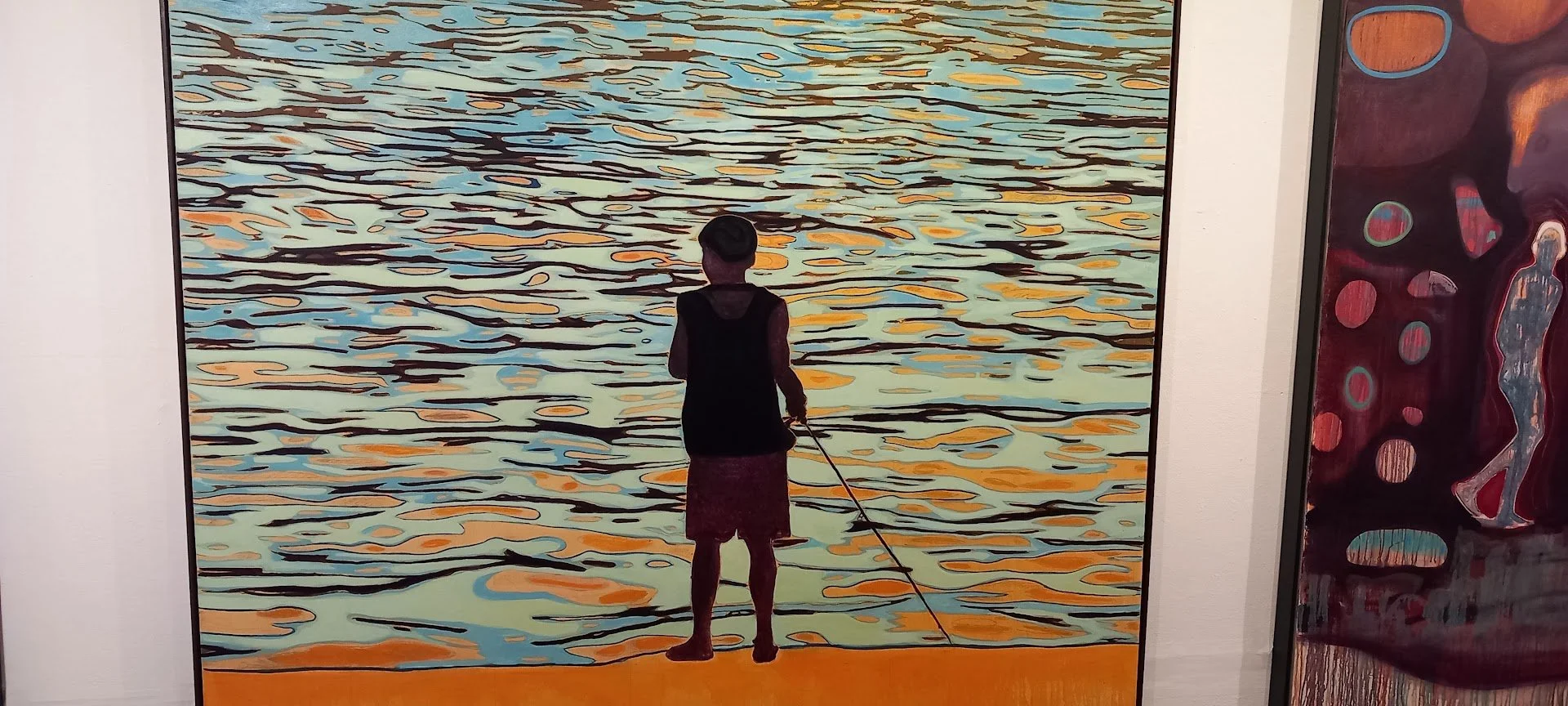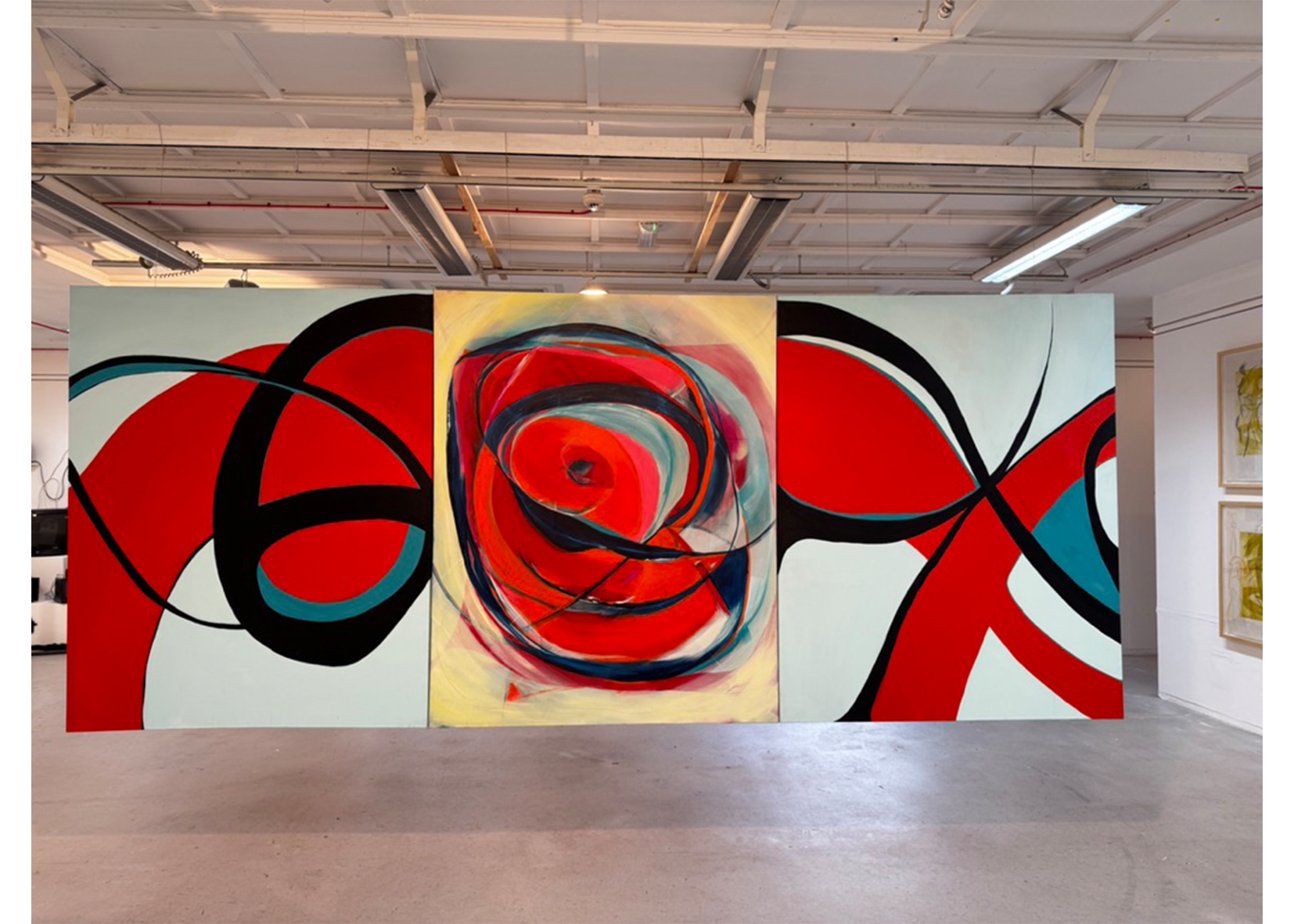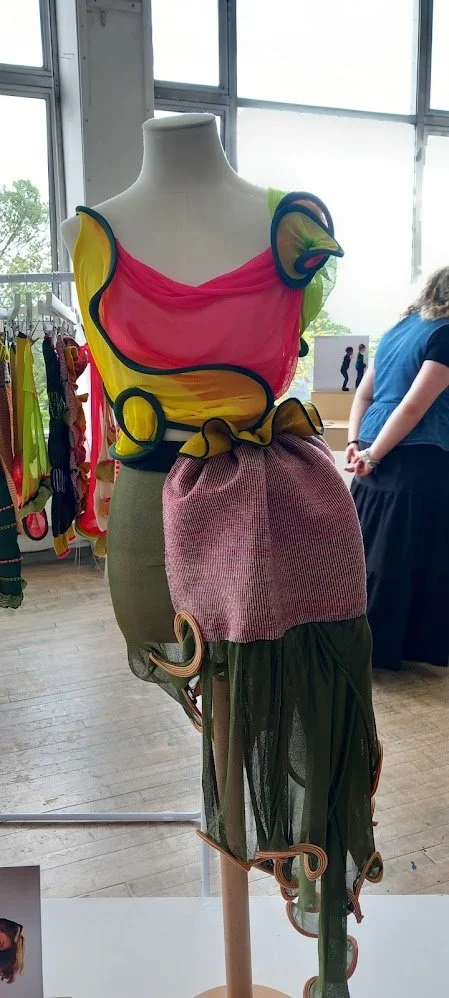Reflecting on the 2025 DJCAD degree show...
Helen Pryde and Gail Low visited the DJCAD degree show this week; they spent three and a half hours at the degree show and visited only the Crawford Building and Cooper Gallery. Both these buildings house many of the fine arts, art and philosophy, textile and jewellery displays, though not all. The visit, and the impressions made by the small sample of work they did manage to see, sparked a reflective exchange about art, exhibitions, artist statements and how they, coming from different disciplinary backgrounds, responded. Helen is a lawyer but she did her undergraduate degree in textile design at the DJCAD, and Gail taught English and Creative Writing for many years in the Humanities division at the University of Dundee.
Gail: Coming from a more traditional academic discipline, entering the art school is always a treat… just more exciting, less quotidian than walking the long corridors of the teaching block of, for example, the Humanities. There is much more on the walls to catch your eyes, more to peer at behind lited closed doors where something mysterious had just occurred but whose traces are still imprinted in the air despite the empty room. Students here sit in studios with desks facing each other; they are, invariably, chatting while they cut, draw, print or paint. There’s a communal companionable feel to all this. To my untutored eye, these activities seem to involve turning base material—paint, ink, clay, cloth and the like—into something thrumming with energy and life. While I realise that more and more of contemporary art has a digital outlet and that I am, of course, in danger of romanticising the difference between book learning and learning by doing, the transformational process of making always seems like alchemy to me. Oh the outright glamour of the art school, where the imaginative doesn’t run in logical straight-line arguments …
Painting by Tom Speedy
Helen: Walking into the degree show at DJAD stirred vivid memories of my own time at the art college in the 1970’s. At that time, the Matthew building had not yet been built. Architects and designers were all taught in the Crawford Building. This meant that the boundaries between disciplines were far more fluid. Architects, designers, sculptors and painters – and indeed staff, interacted in a way that is now probably not possible. On a Friday night the staff room was turned into ‘The Staff Bar’. Students were sometimes allowed in, and discussions would flow over a few wee drams. Many would continue their philosophical intercourse at the ‘Tavern Bar’ in the Hawkhill, and when the pub closed at 10 pm, everyone would inevitably end up in a student flat, drinking tea and eating toast. We would debate design, architecture and philosophical concepts – exchanging ideas late into the evening, (albeit mostly on Fridays). It was such a genuinely enriching and intellectually stimulating environment.
Leading up to the degree show, collaboration would take place between, say, architects and designers, with designers helping architects with their drawings for their final year projects. Design students would work through the night at the Art College finishing their projects. Those nights were commonly known as ‘all-nighters’, and, some of us were entrusted overnight with the keys to the Art College!
Graduates are nowadays awarded Degrees. Back ‘in the day’, prior to the Art College becoming part of the University, design and fine art Graduates were awarded a Diploma in Art and Design, which could be converted to a Degree. Many proudly guarded their Diploma having opposed the transition to ‘university status’ in the first place.
As I walked into this year’s exhibition, I couldn’t help but notice how things have shifted. In my time the exhibits would have been full of life drawings, many paintings, screen-printed materials (some of which were already made into garments or cushions), illustrated story books, and a plethora of graphic packaging. Silversmiths would showcase thoughtfully designed and beautifully crafted pieces. Indeed, people would queue to buy their favourite item(s) in the hope that the person in front of them didn’t want their coveted piece. There was an expectation to showcase finished pieces of work. However, on this particular journey of ours, it became evident that the final degree show is no longer always about the development of a journey over four years and of presenting any ‘finished product’.
On this visit, walking into the ground floor of the Cooper Gallery, we were enveloped in an atmosphere both curious and contemplative. The experience began not with visuals but with sound—a kind of ritualistic chanting that resonated softly through the space. It took a moment to locate its source: a small circle of seated women in a quiet performance, rhythmically placing and removing objects on the floor. It was a hypnotic meditative ritual. Though I could have lingered longer, I was also eager to explore as many exhibits as possible.
The signage directing visitors through the show was at times, ambiguous, but I found that this lack of cohesion encouraged a rather more exploratory wandering and surprise.
Sculpture by Claire Marion Black
Gail: The degree show exhibits are scattered over different buildings, rooms and galleries. Walking down the long corridors between rooms, previously teaching or workshop spaces now co-opted for gallery displays, upstairs to different floors or half levels is a little like entering a labyrinthine rabbit warren. I think it’s better not to worry about what you are missing—that side door that might open out into a whole new vista of art, or just a cleaning cupboard—or be anxious about trying to ‘cover’ everything, ticking off a clipboard list of different art forms and objects that you must see. Better to have time, let the work wash over you. Visit again. Pause… and ponder why this or that speaks to you.
Often first impressions turn on scale and ambition – there’s something compelling about coming face to face with large sculptures, a huge wall of different woodcuts and paintings, portraiture measuring five feet high or more. You let yourself be caught by what is monumental or oddly quirky, pulled in by something tricksy, or some intriguing question or idea. And why not? These students are at college to experiment, to follow their own line of thinking in research and see where the making process leads them.
Artist statements. I do have a beef about them. Sometimes these feel as if they are written primarily for the inner circle of the initiated. Are esoteric terms good things, and we should get off our backsides and google terms we don’t get? (Mobile phones at the ready!) Or are they simply academese? It’s probably a bit of both, for surely engaging with ideas is part of the pleasure of making art at University; Art College, quite rightly, should be a playground of art and ideas. But in order for viewers to participate in the play, some clarity—outreach even—is needed. Sometimes artist statements I read are personal narratives chronicling self-recovery or self-discovery, the art on display a personal journey of sorts; sometimes they are an explanation of the work. But I do love a good artist statement that’s geared not so much at describing, explaining or apologising for the work but one that sits alongside, posing enquiring questions, having a conversation with the artwork itself.
The sheer array of what is on display at the degree show can also be bewildering and the cheek-by-jowl format doesn’t always do justice to the quieter pieces on display when positioned next to bolder and more shouty exhibits.
And because these are students, I also fret about the etiquette of how to react… avoid eye contact with the artist sitting silently on a chair beside her work if you are bewildered by her display and especially if you take little pleasure in what you see? Act and sound like a fangirl if not? Critique is easy but you could be slagging someone’s months of hard work. Sometimes the artist and I pretend we haven’t really seen each other to avoid any awkwardness. Yet the students I did talk to on my visit were very welcoming, and thankful for some kind of conversation however fleeting.
Mixed Media installation by Jessica Pound
Helen: Visiting the show with you, Gail, added another layer to the experience. Our backgrounds—one trained in art, the other not—shaped our perceptions in fascinating ways. There were moments when our reactions diverged significantly. Some exhibits I found impenetrable or emotionally distant. In those instances, I felt compelled to speak directly with the artists, not only to better understand their intentions but to confront my own discomfort or confusion. It reminded me that connection—whether with a person or a piece of art—requires effort, curiosity, and a willingness to admit that we don’t always know.
This kind of cross-disciplinary dialogue between creator and viewer, between trained eye and fresh perspective confirms that Art, at its best offers not just the answers, but more often questions, and in doing so, forges a space for shared reflection.
Gail: The DJCAD degree committee might not deliberately cluster their displays together thematically but there are certainly some discernible ones running through the art work that we saw in the Cooper Gallery to do with a preoccupation with ritual and performance; the challenge and opportunities that modern digital media poses for the planet and how we are to be in the world; art as a process of mark making, forming, scraping back and putting more paint (or something else) on. I was taken by how some artists pose questions rather than give answers by way of explaining their practice—whether these be more personal as about identity or more abstract in form and aesthetics. In the writing of academic essays however, epistemic than rather than heuristic as Sean Sturm observes, we are encouraged to be authoritative and confident in our argument, to evidence and have answers to the questions we pose in our introductions. I am certainly taken by the more heuristic approach here.
The plasticity of forms in expression is wonderful to encounter. Making what is static more fluid and dynamic is certainly evident in Clover Christopherson’s hung translucent cyanotype prints using light projected onto layered wall hangings to suggest immersion and suggest watery stories, reminding us of our aquatic beginnings, as well as how much our bodies are composed of water. How different would life be imagined from the perspective of the river and sea I wonder? Certainly fewer Ozymandias-like grand designs or empires of brick, glass and stone arising and then destroyed. Claire Marion Black’s fascination with rituals and performance suggest mystery and magic, an other world; her rather mysterious sculptural depiction of horses’ heads (in states of decay and ritual destruction) suggest ways in which we (and our ancestors) might have inhabited the land that is perhaps now all but lost. Or felt only as faint traces of some transcendent dreamlike Jungian ‘thin spaces’ that our mostly rational material existence ignores, even represses. The cycle of destruction and decay accompanying the act of ritual invocation offers intimations of a primal somewhere else. Tom Speedy’s large wall paintings and colour palette suggest dream-like states; his painting of the silhouette of young boy fishing set against his painterly water’s lucent quality is stunning; his other pictures seem to suggest the colour of memory in their faded blues, greens and yellows. Malachy McCrimmon’s wall made up of rectangles of painting and laser cut woodcuts (some of which contain texts or poetry) to simulate digital screens is an ambitious mash-up of the contemporary and the traditional. The words inscribed or cut into the wooden rectangles aren’t always easy to read in this ambitious project, and some are deliberately obscured by paint or placed so high up the wall that they can’t be read easily. I wonder if this strategy is part of what he calls ‘glitch aesthetics’? (This is a term I hadn’t come across and so I googled it: art incorporating digital or analog errors, distortions, glitches in a programme as it were.) McCrimmon’s imagined e-jungle, laid out in front of us, bears witness to the dystopian aspects of the natural and the digital, a projection of our ugly industrial military complex perhaps (animals such as an eagle and dolphins co-opted for military purposes). Yet the work has power, and a frenetic relentless critical liveliness that is more than the sum of its parts.
Mixed media installation by Malachy McCrimmon
Which leads me to puzzle over Anney White’s quieter, maybe more conventional abstract painting upstairs from the Cooper Gallery. She manages to transform a 2-D painting into something full of movement, a canvas escaping the confinement of its framing. Both Helen and I pause at White’s canvases, attracted by the sheer pleasure of how pattern and colour suggest energy and fluidity, a reaching out of the frame as if to engage in a more expansive conversation with its outside. Helen and I talk about the tension between the frame and the art framed within. I read and loved White’s artist statement. It forms a puzzling over why and what she has done, and reads less like an explanation of her art and more of an enquiry, an openness to the process of making—‘how a mark can serve as a form of control, but also an act of release. Paint becomes a structure, a gesture, a question. These works are not meant to resolve’. I loved the tonal vulnerability also hinted at in her statement. To my mind, this is the most interesting kind of artist ‘statement’ there is. Less an assertion, more a probing. A conversation with the art made.
Helen: I was particularly struck by the paintings of Anney White. I agree that her work radiated energy, and fluidity, suggesting motion, optimism… and even joy. Her brushwork was expressive, evoking possibilities rather than fixed meanings.
Indeed, in general, I found the fine art that I saw to be striking in its thematic cohesion, often with a strong emphasis on female narratives where work felt intimate, reflective and personal.
Helen: In the design corridors, the textile graduates work stood out immediately, (Although I accept I may be a little biased coming from that discipline).
Their section featured both works in progress and fully realised pieces, offering a glimpse into their creative processes. The displays were alive with excitement, theatre, and a palpable sense of play. Bold colours, inventive designs, and meticulous craftmanship abounded. Large portfolios brimming with ideas, sketches and experiments invited visitors to pause and delve deeper and to touch – it seemed to be an open-ended dialogue between artist and viewer. Indeed – a celebration of possibility, innovation and playfulness.
Dress by Alia McGeoch
Gail: Yes, playfulness. When we were in what seemed like the downstairs dungeons of the Crawford building, we came across two marvellous instances of playfulness. Jessica Pound’s fun cardboard spaceship documents what might be seen on planet Earth by an alien being. In her spaceship, the control panel, the celluloid film canisters and spools, and also developed photographs of humans and their activities are all, surprisingly, made of ceramic. The latter present as if they might be photographic ‘negatives’ (albeit in red and white instead of black and white), their wonderfully detailed and realised snapshots of human activity remind me of artisanal wood or linocuts, and I think the deliberate swerve away from a professionalised glossy artefact or high concept scifi is heartening. Finally, Joy Jenning’s display—a multiplicity of little smooth and textured humanoid figurines in different poses and colours, ‘The Formables’ (what a wonderful name)—is so much fun! These figurines suggest a variety of emotional states both negative and positive, and are grouped together in communal huddles, each figure interacting with others to suggest relationships, an act of interaction, an offer of help even. Viewers are encouraged to take them up, to rearrange them, to ‘create, arrange, project, play, identify, engage, wander and wonder with them in the landscape’, and there are prompt cards to help initiate the play. In doing so, conversations about identity, belonging, and well-being might well arise, encouraging players to move beyond feelings of isolation and inadequacy. Oh, to be able to touch and finger art!
The Formables by Joy Jennings
This idea of play, of having the space and time to experiment; to read, research and pursue your line of enquiry; to hone skills but be driven less by the finished product and more by seeing where making and crafting takes you; to converse with others in the spirit of exploration and challenge, to be able to fail and pick yourself up again are surely what the cloistered spaces of the University should provide. These spaces are, of course, temporary; the world outside awaits. Yet students should be given this precious time to challenge themselves. The arts journalist Marsha Pearce writing of Alice Yard, that renown Trinidadian arts venue, upholds its ethos of play as vital to creating: they are ‘acts that contribute to a conversation and interactions’, involving ‘engagement and imagination’, ‘the thrill and natural intoxication of experimenting, trying new things, collaborating and relating with each other in novel ways. Play is about not knowing where things will lead. Play is about having fun.’ Reading posters mounted by students tacked onto the degree show walls protesting redundancies and threatened course closures due to uneconomic enrolment numbers, a means to come to terms with the University’s management failures, is really like being punched in the gut then. Education needs to be more than big business; when has making money become one of the fundamental reasons for running a University? Sure, you do need money, space and time in order to bring this all together; I am not a complete romantic. Conversations, engagement, imagination, the intoxication of experimenting and collaboration with each other in novel ways, not always knowing where things will lead—these qualities are certainly on display at the Degree show, and so worth upholding… even cherishing.







